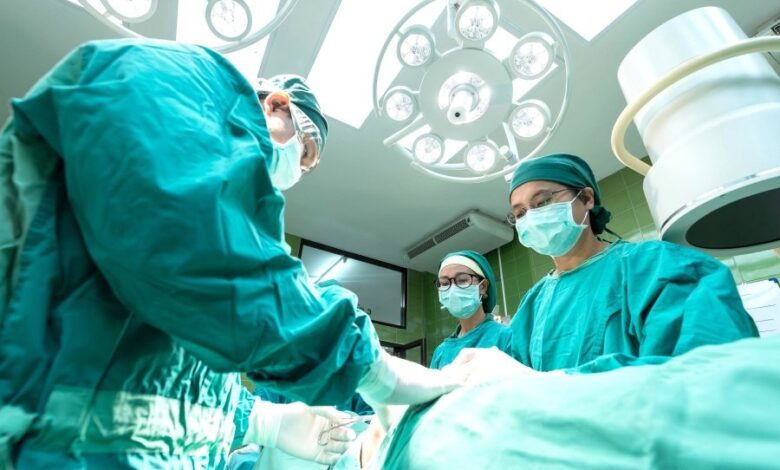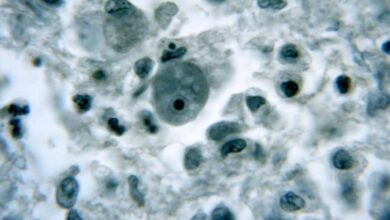Seal leaks in the stomach or intestines

ETH pioneer Alexandre Anthis developed a patch to seal surgical sutures on the intestines or stomach. The engineered material can also detect any leaks at an early stage – thus preventing serious complications.

Surgery. Image credits: pixnio.comCC0 . public domain
For surgeons, shrinking the stomach and removing intestinal tissue have become routine procedures. To this day, however, doctors are still in the dark about whether the stitches they leave in the digestive tract are kept properly.
As a result, one in ten patients still has complications, such as stomach acid or intestinal contents leaking into the abdomen and causing a serious infection. However, detecting leaking sutures from outside the body is extremely difficult; The problem usually goes unnoticed until the patient suddenly has a high fever – a sign of blood poisoning.
Alexandre Anthis, a pioneer member of ETH, said: “The issue of suture leakage after gastrointestinal surgery remains unresolved. “I would never have thought it was still a problem, especially in the rich industrialized countries.”
Anthis, a chemist with a PhD from ETH Zurich, decided to tackle this problem immediately: he spent his PhD trying to find a solution to this important problem and almost a This year, developed a high-tech patch that will not only completely seal stitches in the intestines and stomach, but also provide an early indication of whether those stitches are leaking.
Hydrogel patch for intestines
Anthis’s patch is based on an internal hydrogel embedded with certain chemical sensing elements. These factors respond to changes in pH due to gastric acid secretion or certain enzymes in the intestine. With conventional ultrasound equipment, the doctor can easily and non-invasively check regularly after surgery to see if the patch has changed. As a result, leaks can be detected within 15 minutes of exposure to digestive fluids, in sharp contrast to the time required in hospitals of several days.
“The new patch is expected to not only prevent serious complications, but also cut costs across the entire healthcare system. That’s because complications often lead to a longer stay in the intensive care unit and a longer recovery time,” says Anthis. He cites figures from the US healthcare market: if complications occur after surgery, patients have to stay in intensive care twice as long. In fact, vascular surgeons have used self-adhesive patches, which are based on proteins like fibrin, but these materials don’t hold up long when digestive juices leak. Anthis hopes that “our technology will both protect patients and be an important tool for physicians.”
Doctoral thesis as the foundation
Anthis doctoral advisor, Inge Herrmann, Professor of Nanoanalytical Systems at ETH Zurich, came up with the idea of developing an enteric patch. Anthis tells how Professor Herrmann and her team maintained a stimulating dialogue with a number of doctors and surgeons; In such an exchange, the need to minimize complications after gastrointestinal surgery emerged.
Herrmann then tasked Anthis with developing a solution to this problem in his doctoral thesis – a task he accomplished brilliantly. Thanks to his track record, Anthis has been included in Forbes’ “30 Under 30” list in 2022. Since completing his PhD a year ago, he has been working on further product development and bring it to market. 150,000 Swiss francs in seed money from the Pioneer Fellowship covers his salary for a year and a half, and Professor Herrmann provides him with a laboratory, materials and infrastructure.
Main market potential
Anthis also coined a name for his future company: Veltist, derived from the Greek word veltistos, which means a simple yet powerful solution. His plan is to start the company by the end of 2022, or possibly a year later, depending on how the pig trials are planned. The gastrointestinal tract in pigs is very similar to that of humans and is therefore considered a good model. These tests will then be followed by the first clinical phase with human tests.
In other words, Anthis still has a lot of work ahead of him and his efforts to further develop the patch are not without challenges. “Ultimately, we wanted it to break down in the body while tolerating adverse abdominal conditions for as long as possible. At the same time, we don’t want it to trigger the immune system,” Anthis explains. It won’t be easy to reconcile all these demands, but he is undeterred. “I love playing with different materials and creating new things with them, so this is really the perfect job for me at the moment.”
He is also in contact with a large medical technology company. Postoperative enteral leakage is a significant problem, and the market is correspondingly large. In Switzerland alone, 120,000 people have gastrointestinal surgery each year; worldwide number is 14 million. “It’s a huge market with great potential,” Anthis says — and he’s sure he can make a breakthrough.
Meaningful but hardworking
“I find it very satisfying to develop something that is really needed,” Anthis said, before immediately speaking in a more serious tone: “A project like this requires coordination and hard work on many facets to even having a chance from a clinic lab.” But, as he goes on to point out, the reality is that an individual’s hard work may not be enough to get there. The most important for this type of project is to assemble a great staff.
It is clear that this project is close to Anthis’s heart. He said that he is working hard and putting in many hours at the moment. “It’s completely crazy sometimes,” he said, laughing, “but we young entrepreneurs live by that pain.”
Source: ETH Zurich




